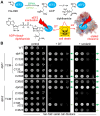Functional Integrity of Radical SAM Enzyme Dph1•Dph2 Requires Non-Canonical Cofactor Motifs with Tandem Cysteines
- PMID: 38672486
- PMCID: PMC11048331
- DOI: 10.3390/biom14040470
Functional Integrity of Radical SAM Enzyme Dph1•Dph2 Requires Non-Canonical Cofactor Motifs with Tandem Cysteines
Abstract
The Dph1•Dph2 heterodimer from yeast is a radical SAM (RS) enzyme that generates the 3-amino-3-carboxy-propyl (ACP) precursor for diphthamide, a clinically relevant modification on eukaryotic elongation factor 2 (eEF2). ACP formation requires SAM cleavage and atypical Cys-bound Fe-S clusters in each Dph1 and Dph2 subunit. Intriguingly, the first Cys residue in each motif is found next to another ill-defined cysteine that we show is conserved across eukaryotes. As judged from structural modeling, the orientation of these tandem cysteine motifs (TCMs) suggests a candidate Fe-S cluster ligand role. Hence, we generated, by site-directed DPH1 and DPH2 mutagenesis, Dph1•Dph2 variants with cysteines from each TCM replaced individually or in combination by serines. Assays diagnostic for diphthamide formation in vivo reveal that while single substitutions in the TCM of Dph2 cause mild defects, double mutations almost entirely inactivate the RS enzyme. Based on enhanced Dph1 and Dph2 subunit instability in response to cycloheximide chases, the variants with Cys substitutions in their cofactor motifs are particularly prone to protein degradation. In sum, we identify a fourth functionally cooperative Cys residue within the Fe-S motif of Dph2 and show that the Cys-based cofactor binding motifs in Dph1 and Dph2 are critical for the structural integrity of the dimeric RS enzyme in vivo.
Keywords: ADP-ribosylation; Dph1•Dph2; Saccharomyces cerevisiae; cysteine ligands; diphthamide modification; eEF2; iron sulfur cluster; radical SAM enzyme.
Conflict of interest statement
K.M. and U.B. are employed by and members of Roche Pharma Research & Early Development (pRED) and are co-inventors on patent applications that cover assays to detect the presence or absence of diphthamide. Roche is interested in targeted therapies and diagnostics. All other authors declare no conflicts of interest.
Figures




Similar articles
-
DPH1 Gene Mutations Identify a Candidate SAM Pocket in Radical Enzyme Dph1•Dph2 for Diphthamide Synthesis on EF2.Biomolecules. 2023 Nov 16;13(11):1655. doi: 10.3390/biom13111655. Biomolecules. 2023. PMID: 38002337 Free PMC article.
-
Dph3 is an electron donor for Dph1-Dph2 in the first step of eukaryotic diphthamide biosynthesis.J Am Chem Soc. 2014 Feb 5;136(5):1754-7. doi: 10.1021/ja4118957. Epub 2014 Jan 22. J Am Chem Soc. 2014. PMID: 24422557 Free PMC article.
-
The asymmetric function of Dph1-Dph2 heterodimer in diphthamide biosynthesis.J Biol Inorg Chem. 2019 Sep;24(6):777-782. doi: 10.1007/s00775-019-01702-0. Epub 2019 Aug 28. J Biol Inorg Chem. 2019. PMID: 31463593 Free PMC article.
-
The diphthamide modification pathway from Saccharomyces cerevisiae--revisited.Mol Microbiol. 2014 Dec;94(6):1213-26. doi: 10.1111/mmi.12845. Epub 2014 Nov 17. Mol Microbiol. 2014. PMID: 25352115 Review.
-
Novel compound heterozygous DPH1 mutations in a patient with the unique clinical features of airway obstruction and external genital abnormalities.J Hum Genet. 2018 Apr;63(4):529-532. doi: 10.1038/s10038-017-0399-2. Epub 2018 Jan 23. J Hum Genet. 2018. PMID: 29362492 Review.
References
-
- Nicolet Y. Structure–function relationships of radical SAM enzymes. Nat. Catal. 2020;3:337–350. doi: 10.1038/s41929-020-0448-7. - DOI
Publication types
MeSH terms
Substances
Grants and funding
LinkOut - more resources
Full Text Sources
Research Materials
Miscellaneous

